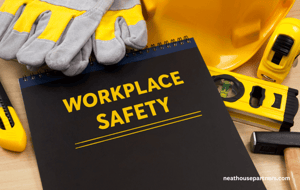Preparing for the Unexpected: Emergency Response Planning for Employers
Preparing for the Unexpected: Emergency Response Planning for Employers
James Rowland
Commercial Director James leads Account Management, Sales and Marketing at Neathouse Partners.Date
16 May 2023Updated
20 March 2024
The Health and Safety at Work etc. Act 1974 requires employers to ensure employee health, safety, and welfare, including a safe working environment and emergency procedures.
As a result, all employers need to create an effective emergency response plan which should cover possible emergency scenarios with detailed instructions on how to protect employees and respond to potentially dangerous situations.
An emergency response plan is vital for business continuity when the unexpected happens, so it must be tailored to the company's specific needs and circumstances, regularly tested, evaluated, and updated to ensure it remains effective and aligned with current best practices.
What Is An Emergency Response Plan?
An emergency response plan is a set of written procedures that helps employers prepare and respond to emergencies, such as fires, hazardous material spills, or natural disasters.
It is something that business owners hope they will never need to use but is essential to have.
The plan outlines the steps needed to protect employee safety and minimise damage in an emergency.
It should include strategies for responding to each type of potential emergency and detail who will be responsible.
What To Include In An Emergency Response Plan
The plan should start with a clear statement of the company’s goals in the event of an emergency, such as evacuating the premises, providing medical attention, or protecting vital assets.
The plan should also identify all necessary personnel and specify their roles in an emergency, including fire wardens, first-aid responders, and emergency coordinators.
A detailed description of the building’s layout and exits, as well as a comprehensive evacuation map that indicates escape routes should also be included, and the whole thing needs to be stored in an easy-to-access place.
Tips For Drafting Your Businesses' Action Plan
- Assess Potential Risks: Conduct a comprehensive assessment of potential hazards in your workplace. This may include natural disasters (e.g., earthquakes, floods), fires, chemical spills, medical emergencies, or security incidents. Identify specific risks that are relevant to your location, industry, and business operations.
- Establish an Emergency Response Team: Form an emergency response team comprising individuals from different departments or job roles. Assign responsibilities and designate specific roles such as incident commander, communication coordinator, first aid officer, or evacuation coordinator. Ensure team members receive appropriate training and have access to necessary resources.
- Develop Communication Protocols: Establish clear communication protocols for emergencies. Determine how employees will be notified of an emergency and establish a reliable system to disseminate critical information. Consider utilising multiple communication channels, such as text messages, email, public address systems, or smartphone apps.
- Create Emergency Evacuation Plans: Design evacuation plans tailored to your workplace layout. Mark emergency exits, assembly points, and routes to be used during evacuations. Conduct regular drills to familiarise employees with evacuation procedures and evaluate the effectiveness of the plans. Make provisions for employees with disabilities or special needs.
- Implement First Aid and Medical Support: Ensure that your workplace is equipped with first aid kits and that designated personnel are trained in first aid and CPR. Consider establishing relationships with nearby medical facilities to provide immediate medical support during emergencies. Maintain up-to-date emergency contact information for employees.
- Secure Physical and Data Assets: Safeguard physical assets by implementing appropriate security measures, such as access controls, surveillance systems, and alarm systems. Regularly back up important data and establish off-site data storage to prevent data loss during emergencies.
- Review Insurance Coverage: Evaluate your insurance policies to ensure they adequately cover potential risks and emergencies. Understand the claims process and maintain up-to-date records of assets and inventory.
- Train and Educate Employees: Conduct regular training sessions to educate employees about emergency procedures, safety protocols, and the proper use of safety equipment. Provide information on how to recognise potential risks and report them promptly.
- Continually Assess and Update the Plan: Regularly review and update your emergency response plan to reflect any changes in your organisation, workforce, or operations. Incorporate lessons learned from drills or actual emergency incidents. Seek feedback from employees and the emergency response team to improve the plan's effectiveness.
- Coordinate with External Resources: Establish partnerships or agreements with local emergency services, such as fire departments, police, or emergency medical services. Inform them about your emergency response plan and provide them with relevant information about your workplace to facilitate a coordinated response during emergencies.
Read more: Emergency evacuation plans and vulnerable workers
How To Store Your Emergency Plan
To ensure easy accessibility of your emergency response plan at work, consider the following storage options:
- Digital storage: Save an organised and searchable electronic copy on your company's shared drive or intranet.
- Printed copies: Distribute printed copies to key personnel and departments, placing them in visible locations like break rooms and notice boards.
- Employee handbooks: Incorporate the plan as a section in the employee handbook, updating it regularly.
- Emergency response kits: Include a copy in emergency response kits and safety stations throughout the workplace.
- Training materials: Integrate a section or summary into training materials and employee orientation sessions.
- Online platforms: Utilise secure web-based platforms or intranets for easy access from any device with an internet connection.
- Periodic reminders: Regularly remind employees about the plan's location and availability through emails, meetings, or signage.
Legislation Covering Emergency Procedure Planning For Employers
UK employers must ensure that the workplace is safe and healthy for their employees, and this may be governed by specific regulations depending on location, industry, and organisation size.
Employers need to be knowledgeable about and adhere to UK legislation regarding emergency procedure planning, including the following:
- Health and Safety at Work etc. Act 1974: It requires employers to ensure employee health, safety, and welfare, including a safe working environment and emergency procedures.
- Regulatory Reform (Fire Safety) Order 2005: It mandates employers to conduct fire risk assessments, implement fire safety measures, and provide fire safety training.
- Management of Health and Safety at Work Regulations 1999: These regulations demand employers assess and manage workplace risks, including emergencies, and implement control measures.
- Control of Substances Hazardous to Health (COSHH) Regulations 2002: It outlines measures for handling hazardous substances and requires employers to have emergency procedures for incidents involving such substances.
- The Civil Contingencies Act 2004: Establishes a national framework for emergency planning and response, outlining the responsibilities of organisations, including businesses.
Summary
Having a comprehensive emergency response plan in place is essential to prepare your business and employees for potential emergencies.
It ensures that everyone will remain safe, informed, and organised during an emergency.
Make sure you consult relevant legislation when creating and updating your plan, store it securely, and provide training sessions to educate employees on the procedures outlined in the plan.
The expert team at Neathouse Partners can help you to manage or meet your employer's responsibilities relating to emergency response planning.
Contact us on 01244 893776 to book a free, no-obligation call with one of our experienced team.
Related blog posts

Promoting a Culture of Safety: Strategies for Encouraging Employee Buy-in and Engagement

Managing Health and Safety During a Pandemic: Lessons Learned and Best Practices for Employers

Driving Safety Innovation: The Future of Enhanced Safety for Employers
Have questions?
Get in touch today
Contact us, and our team will get back to you within 24 hours. We value your questions and are committed to getting them answered quickly.


Hello! I am Nicky
Just fill in the form below with your details, and I will arrange for a member of our team to give you a call.
By clicking, you agree to our Privacy Policy







